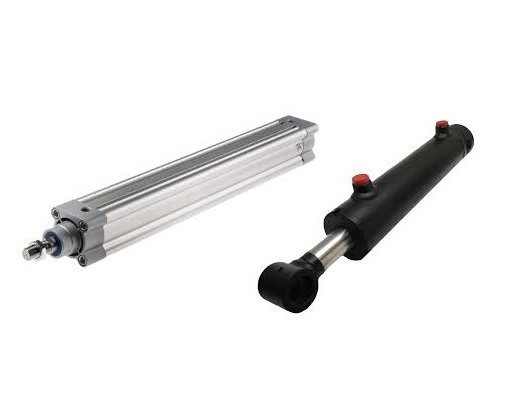INDUSTRIAL SAFETY AND AUTOMATION CONSULTING PTY LTD (ISAAC)
Did You Know? - Part 1 – A critical safety consideration of a pneumatic or hydraulic cylinder driven load.
Through the following information, we intend to create awareness of a common, dangerous and often hidden hazard that can be overlooked during hazard identification of industrial machinery. The contents on this page have been summarised into the important fundamentals to be better understood by all readers and prevent the information from being perceived as ‘too technical’. If you are a duty holder with respect to OH&S and industrial machinery, we encourage you to continue reading, as you may gain from the key points.
Did you know there are a range of failure modes with pneumatic and hydraulic systems that can lead to a sudden intensification of pressure in a cylinder, and subject to the design, result in unexpected abnormally rapid actuation and travel of cylinders?
Unexpected movement combined with abnormally rapid travel of a cylinder is a hazard that has led to both harm and fatality. Unfortunately, knowledge of this type of hazard and the appropriate safety controls are often absent during hazard and risk identification and risk mitigation.
To understand just one scenario in which this type of hazard could occur, let’s use an example of a long stroke pneumatic cylinder undertaking the power assisted opening and closing of a horizontal sliding door of an industrial machine. For this example, we’ll expect that the operator would typically press a button to request closure or opening of the door. The door in normal circumstances would travel at a slow speed governed by standard pneumatic flow controls, which will have been pre-set under the normal operating conditions. A bump strip has been fitted to the leading edge of the door so that if an operator is struck by a normally avoidable hazard of the slow-moving door during closure, the directional control valve of the door cylinder is immediately switched off and we’ll further include for our example that a monitored safety valve is de-energised. We’ll add to our example that there is also an emergency stop button immediately adjacent to the door that provides that de-energises the pneumatics in the same way as the bump strip.
This is typical of safety controls we often encounter, but we may be misguided in thinking that this configuration provides safe control without additional measures.
Now we’ll introduce into our example a foreign object that has unexpectedly found itself on the door track. It could be as simple as a bolt that has shaken free from elsewhere on the machine or a misplaced tool or part. The door begins to close normally, but part way through the closure its front track guide jams upon the foreign object. Whilst the door is now stuck, the directional control valve remains open and continues to charge the long stroke cylinder, which continues to try and push the door closed, while intensifying to full pneumatic system pressure within the cap end of the cylinder. The operator sees the cause of the jam and without further thought removes the obstacle expecting the door to continue normally or require reset of its operation. Another possible scenario might be that while the operator has their body in the path of the door looking for the cause of a jam, the door unexpectedly frees itself, due to the accumulated pressure. What could the result be?
A door that normally operates slowly, could now close under intensified pressure. This means it could move unexpectedly, potentially with rapid acceleration, at a dangerously high speed and with significant force. If the door strikes the operator there is a likelihood of serious harm or worse. By the time the bump strip is actuated, considering the possible speed and force of the cylinder and the time taken by safety controls to de-energise valves, the damage from a high-speed impact and a possible crushing hazard will have already been done.
In this example, we referred to a pneumatic cylinder assisting a door. However, potential hazards resulting from cylinder intensification, unexpected lurching, or unexpected movement should be considered in all pneumatic and hydraulic cylinder applications. Whilst a hydraulic cylinder may not move as rapidly as a pneumatic cylinder due to fluid viscosity, it should be remembered that it is also often providing far greater force.
(Technical note & warning: A safe solution should not be reliant on placing two DCV’s in series with the cylinder and safety monitoring a 'pressure switch' or 'pressure sensor' after each of those DCV’s. That configuration has been known to be instructed as a solution in some learning programs delivered by others. However, please be aware that it can leave the circuit subject to an undetected fault, which through accumulation of faults, has the potential to result in a dangerous condition. This will be discussed in a ‘did you know’ for another day).
Whilst warnings of these hazards are often prominent in cylinder installation instructions, their understanding and relevance seems to incorrectly ‘slip through the cracks’ during the evolution of the machinery to its point of use. If these types of hazards are not identified, there will be no awareness of potentially very high-risks to personnel.
This also lends understanding to why broader knowledge and experience (not just of electrical safety control or limited fluid power application) should be engaged when identifying pneumatic and hydraulic safety hazards, their failure modes, risks and solutions.
We hope the above generates thought, potentially contributes to safer workplaces, and furthers understanding of how easily unforeseen hazards can occur with pneumatic and hydraulic equipment.
Could your hazard identification and risk assessment team achieve safer practical outcomes with additional skills and insights?
Written and published by isaacservices.au, 02/04/2024.(Rev3)
